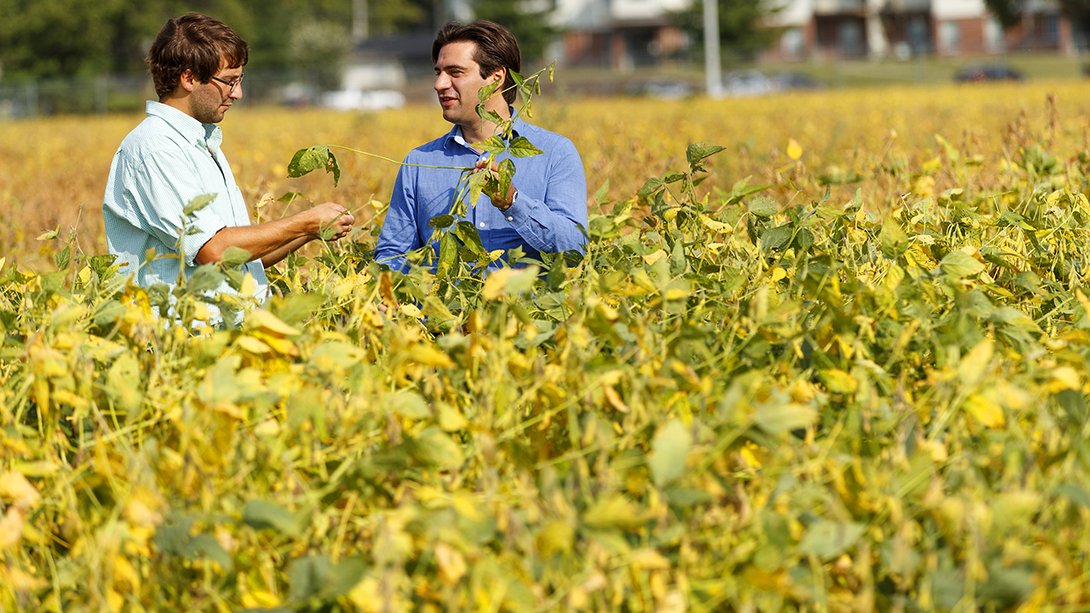
Soybean crops in highly productive fields demand more nitrogen than natural sources alone can supply, says a new study from University of Nebraska-Lincoln and Argentine researchers.
Because nitrogen fertilizer is rarely applied in soybean fields, the crops depend exclusively on two natural processes to provide it. Microorganisms living in soybean roots convert nitrogen into a biologically useful form before trading it to soybeans in exchange for carbon – a process called nitrogen fixation. And the mineralization of organic matter in soil likewise releases nitrogen that plant roots readily absorb.
But the yields of soybean fields that produce more than roughly 50 bushels per acre – the average U.S. soybean yield – are limited by the amount of nitrogen they receive from those natural sources, the study reported.
“It has been a longstanding question whether the nitrogen supply from nitrogen fixation and mineralization is sufficient to sustain high soybean yields,” said author Patricio Grassini, assistant professor of agronomy and horticulture.
Large amounts of fertilizer did not boost soybean yields below that threshold, suggesting that the natural sources supplied enough nitrogen in those fields. However, the researchers found that nitrogen fertilizer consistently boosted yields above the 50-bushel threshold. When applied to the study’s most productive soybean fields – those with the potential to produce 80 or 90 bushels per acre – fertilizer increased yields by up to 10 bushels per acre.
Grassini and doctoral student Nicolás Cafaro La Menza described the study as a “first step” toward better understanding which conditions warrant the application of nitrogen, an element critical to plant growth.
“It allows us to understand two very important pieces of information,” said Grassini, assistant professor of agronomy and horticulture. “We know the maximum response you will get even if you apply a lot of nitrogen. That will help keep expectations on yield responses at a reasonable level. And we now know at which level that response is likely to occur. In other words, we are starting to understand the ‘where’ and the ‘how much.’”
Yield signs
Soybeans need a lot of nitrogen – about four times as much as corn. The greater the potential yield of a given field, the less likely it is that soil alone will provide all the nitrogen those crops require, Cafaro La Menza said.
“As soybean yields increase, they will need more nitrogen,” Cafaro La Menza said. “But we didn’t really know if the nitrogen from the soil and fixation would be enough. So the idea was to quantify if there was a nitrogen limitation.”
To isolate the impact of nitrogen on soybean yields, the team needed to ensure that the soybeans were receiving enough nitrogen throughout their growth cycle. The team began by estimating the maximum potential yields and associated nitrogen requirements of soybean plots in Nebraska and Argentina. Using that information, the researchers then applied precise amounts of fertilizer at strategic times throughout the growing season.
“It’s like going in with a spoonful of the nitrogen whenever the crops need it,” Grassini said.
Comparing the yields of nitrogen-fertilized plots with those from unfertilized sites allowed the researchers to establish the yield threshold and measure the degree of nitrogen limitation across a wide range of environments.
Next-gen nitrogen
Though the team’s study helped clarify questions about the nitrogen needs of soybeans, it did so by applying amounts of nitrogen that would not prove profitable or environmentally responsible on a large scale, Grassini said. Addressing that challenge, he said, could involve either applying small amounts of nitrogen at key stages or finding ways to improve the nitrogen-supplying performance of the symbiotic microorganisms.
“It’s very important to think strategically looking forward – to start looking at the production that will come to us maybe 10 or 20 years down the road,” Grassini said. “At that point, most Nebraska producers ill be producing much higher yields than today. The question is: How will we be able to provide sufficient nitrogen to these crops so that they can realize their potential?
“We’re thinking about the cropping systems of the future. That’s why it’s so exciting.”
The researchers detailed their findings in the journal Field Crops Research. Grassini and Cafaro La Menza authored the study with Juan Pablo Monzon of Argentina’s National Scientific and Technical Research Council, along with James Specht, professor emeritus of agronomy and horticulture at Nebraska. Nebraska Extension educators Jennifer Rees, Keith Glewen, Todd Whitney and Amy Timmerman helped conduct on-farm experiments in Nebraska.
The team received support from the Nebraska Soybean Board and Argentina’s Ministry of Science and Technology.







